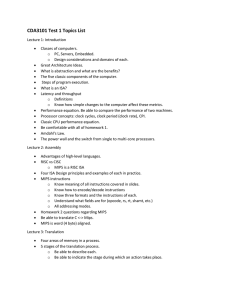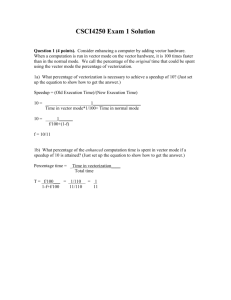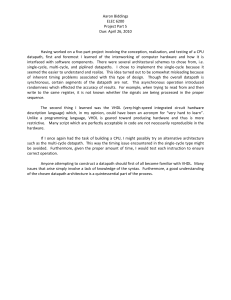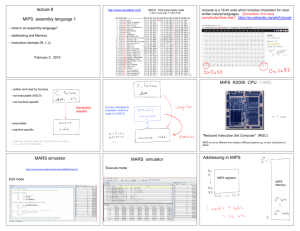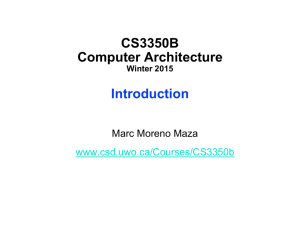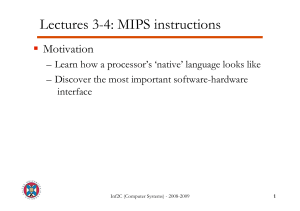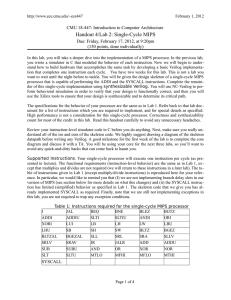MIPS single-cycle implementation
advertisement
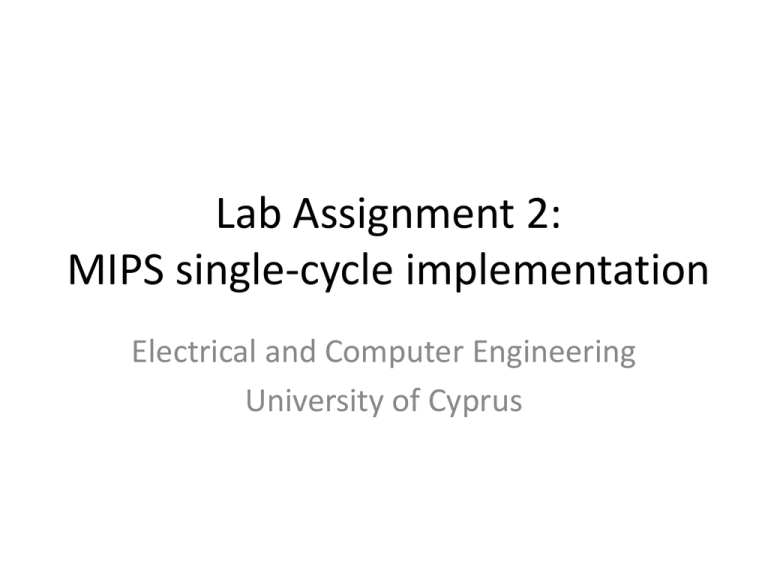
Lab Assignment 2: MIPS single-cycle implementation Electrical and Computer Engineering University of Cyprus Lab Tutorial Assignment • ISE Tool setup • Any Questions? • A solution/tutorial will be uploaded once all assignments have been submitted The Five Classic Components of a Computer Processor Input Control Memory Datapath Output • Datapath: The processor elements that operate on and/or store data • Control: The processor element that decides how and when parts of the datapath are executed FSM INTRODUCTION • The MIPS processor, designed in 1984 by researchers at Stanford University. • Is a RISC (Reduced Instruction Set Computer) processor. Compared with their CISC (Complex Instruction Set Computer) counterparts (such as the Intel Pentium processors), RISC processors typically support fewer and much simpler instructions. • A RISC processor can be made much faster than a CISC processor because of its simpler design. INTRODUCTION (…) • RISC processors typically have a load-store architecture. • Two instructions for accessing memory: – a load (l) instruction to load data from memory, – a store (s) instruction to write data to memory. • None of the other instructions can access memory directly. 5-Stage MIPS Stage 5 PC Instruction Memory (Imem) Stage 1 Registers Stage 2 ALU Stage 3 IFtch Dcd Exec Mem WB Reg ALU IM DM Reg Data Memory (Dmem) Stage 4 STAGES OF EXECUTION IN MIPS 5 stage instruction pipeline 1) I-fetch: Fetch Instruction, Increment PC 2) Decode: Instruction, Read Registers 3) Execute: Mem-reference: Calculate Address R-format: Perform ALU Operation 4) Memory: Load: Read Data from Data Memory Store: Write Data to Data Memory 5) Write Back: Write Data to Register Block Diagram of MIPS single-cycle processor Datapath elements • Instruction memory – PC register, adder increment PC by 4 • Register file • ALU • Data memory Da ta Re g ister # PC A d d re ss In stru ction m e m ory In stru ctio n R e giste rs ALU A d dre ss Re g ister # D a ta m e m ory Re g ister # D ata Edge Triggered Methodology • Unclocked vs. Clocked • Clocks used in synchronous logic – when should an element that contains state be updated? — wouldn't want to read a signal at the same time it was being written falling edge cycle time rising edge Edge Triggered Methodology Register file • A clocking methodology defines when signals can be read and written S tate e le m en t 1 S ta te elem en t 2 C o m bina tio na l lo gic Write Data to Memory C loc k c yc le Instruction Read From Memory Value Written to Register File Read Register Values Execute The MIPS instructions format Single-cycle Implementation • All operations take the same amount of time a single cycle • long cycle time • Instructions same size • Source registers always in same place • Immediates same size, location • Operations always on registers/immediates LAB2 • You will become familiar with the MIPS instruction set by implementing a single-cycle core in VHDL – The example code will be uploaded to the website • You have two weeks for this project – don’t wait until the night before to tackle LAB2 • You will be given the design skeleton of a single-cycle MIPS processor that is capable of performing some instructions. • Complete the design of the single-cycle implementation in order to support the required MIPS instruction set. MIPS 32 Instruction Set - We're ready to look at an implementation of the MIPS - Simplified to contain only: - memory-reference instructions: lw, sw - arithmetic-logical instructions: add, sub, and, or, slt - control flow instructions: beq - Generic Implementation: - use the program counter (PC) to supply instruction address - get the instruction from memory - read registers - use the instruction to decide exactly what to do MIPS IFETCH CONTROL EXECUTE DMEMORY IFETCH IFETCH IDECODE DEMO • You'll want to build a suite of test programs to test the new capabilities of your implementation as you add them. – Test Programs are Stored in the IFETCH.vhd file • You will be expected to run a number of supplied programs. REPORT • • • • • Objective of this lab and intro. Your implementation Your test programs and results (simulations) Your conclusion Attach your VHDL source code (email) Important Announcements! • Lab material (Tutorials, VHDL Files) will be uploaded in the website! • Deadline for Lab 2 is on: 1/10/2014 • No Lab Lecture next week, but we can be at the lab if there are questions Adding Instructions to MIPS (Tutorial) • Branch not Equal (Bne) • Load Upper Immediate (Lui) Branch Not Equal (Ben) Load Upper Immediate (Lui)

